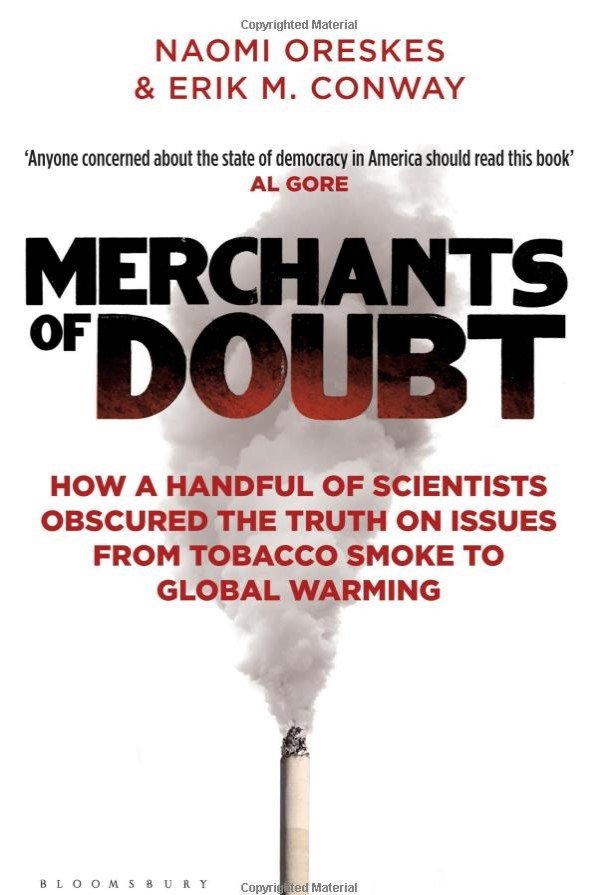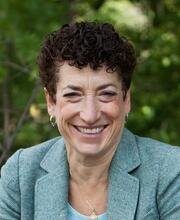Note: this post was co-written with our colleague, Dr. Willie Soon, who was contacted in July 2020 by a BBC Radio 4 producer to comment on a podcast they were planning which was apparently inspired by the Merchants of Doubt conspiracy theory. An early draft of this post was included as “Attachment 2” of his response to the producer. See here for his full response.
Introduction
Naomi Oreskes and Erik Conway wrote a very popular book in 2010, called “Merchants of Doubt”, in which they claim that the entire climate sceptic (or “climate denial” in their view) movement was driven by four prominent U.S.-based retired scientists, who they claim were morally corrupt and had abandoned genuine scientific inquiry. Three of these scientists were deceased by 2010, and the remaining scientist passed away in 2020.
Yet, Oreskes & Conway’s conspiracy theory remains remarkably popular among those trying to dismiss anybody who disagrees with the UN Intergovernmental Panel on Climate Change’s statements on climate change. The book is even cited favourably in academic publications.
However, as we discuss in this post, their conspiracy theory is remarkably illogical and inconsistent and doesn’t stand up to critical scrutiny.
What is the Merchants of Doubt conspiracy theory?
In their 2010 book, “Merchants of Doubt: How a Handful of Scientists Obscured the Truth on Issues from Tobacco Smoke to Climate Change”, Naomi Oreskes and Erik M. Conway argue a remarkable conspiracy theory in which they claim that four physicists are singlehandedly responsible for the entire climate sceptic movement. Three of these physicists (Robert Jastrow, William Nierenberg and Frederick Seitz) had been dead for several years before Oreskes & Conway wrote the book, and the remaining one of them (S. Fred Singer) passed away in April 2020.

If the Merchants of Doubt conspiracy theory were genuinely true then it would actually imply that the narrative on climate change which Oreskes and Conway promote is remarkably flimsy. After all, if the science behind their narrative was as genuinely compelling as they insist, then why was the research of one retired and three deceased physicists sufficient to undermine it?
Admittedly, all four scientists were highly intelligent, well-respected and accomplished scientists who had individually made substantial contributions to scientific progress over the 20th century, including in the study of the Earth’s climate. For instance, Fred Singer was one of the architects of the 1957/1958 International Geophysical Year which led to an unprecedented improvement in the world’s weather and climate monitoring systems, including the first weather satellites, and Robert Jastrow founded the NASA Goddard Institute for Space Studies – a NASA institution with a particular focus on the Earth’s atmosphere and climate.
However, if Oreskes and Conway’s narrative was as scientifically rigorous as they claim, how were these four scientists still easily able to provide compelling scientific critiques against it which (according to Oreskes and Conway) majorly altered public opinion?
Moreover, as we will see below, the book is littered with numerous logical inconsistencies in their arguments which beggar belief. The following are just a few examples (from the climate change chapter).
Examples of Oreskes & Conway’s logical inconsistencies
Oreskes & Conway’s conspiracy theory is littered with logical inconsistencies were the alleged vices of the villains in their story could equally as well be applied to their heroes. Similarly, most of the praises that they heap on their heroes could equally be given to their supposed villains. For example:
1. According to Oreskes & Conway, we should listen to the oceanographer, Roger Revelle, because he was the director of the Scripps Institution of Oceanography from 1950-1964. But, we should ignore Bill Nierenberg, the director of the Scripps Institution from 1965-1986, because he was a physicist.
2. They say we should listen to physicist James Hansen, because he was the director of the NASA Goddard Institute from 1981-2013. But, we should ignore Robert Jastrow, the founding director of the NASA Goddard Institute from 1961-1981, because he was a physicist.
3. Apparently, we should listen to the MIT meteorologist, Jule Charney, because he said we should be worried about Anthropogenic Global Warming (AGW). But, we should ignore the MIT meteorologist, Richard Lindzen, because he says we shouldn’t be that worried about Anthropogenic Global Warming.
4. They claim we should be shocked that Patrick Michaels was, “… presented as an expert who somehow knew more than all the scientists working within the IPCC umbrella”, even though, as a former IPCC climate scientist, he was indeed part of that “umbrella”.
Indeed, this criticism is worth digging into even further. Are they implying that “the IPCC” as a collective knows far more than the individuals which actually make up the IPCC? Why? Because of the “rigorous” review process involved? If so, then are they not worried about that process when they noted in their book that Michaels, “…complained in the hearing that while he’d made many critical comments on the various chapters of the IPCC report, his comments had been ignored, resulting ‘in not one discernible change in the text of the IPCC drafts'”?
5. The emphasis on Benjamin Santer’s “fingerprint” study in the 1995 IPCC report was partly justified by Oreskes & Conway because Santer got the idea for doing the study from Klaus Hasselmann, who was “a physicist who spent much of his spare time working on unification theory”. But, weren’t Oreskes & Conway supposed to be telling us that physicists don’t know enough about climate to have scientifically valid opinions on climate change?
6. The other main justification Oreskes & Conway give for the Santer et al. study being “fact” is that they were looking at the vertical structure of temperature. This was important to Oreskes & Conway because “V. Ramanathan, a prominent atmospheric scientist, had suggested (it)”. But, if looking at the vertical structure of temperature is as key to Anthropogenic Global Warming theory as Oreskes & Conway imply, why don’t they bother mentioning the ongoing debate about whether or not the tropical tropopause has a “missing hot spot”?
7. Indeed, throughout the book they criticise Fred Singer and the others for carrying out much of their correspondence in the media, rather than in the peer reviewed literature. It is true that Singer hadn’t recently published many peer reviewed papers when Oreskes & Conway were writing their book. Nor had the other three physicists they vilify in the book, which is understandable since they were already long-deceased at the time. But, most of Singer’s recent peer reviewed papers at the time had been on the “hot spot” debate, e.g., Douglass et al., 2008 – a paper specifically responding to the work of Santer et al. Why didn’t Oreskes & Conway mention that?
Indeed, since Oreskes and Conway claim to be interested in the sociology behind climate science, it is odd that they didn’t they interview Douglass or any of the others arguing that there is a missing hot spot. There’s an interesting essay by Douglass & Christy about the Douglass et al. vs. Santer et al. controversy in this American Thinker essay from December 2009. Admittedly, the essay was only written a short while before the 1st edition of Oreskes & Conway’s book, so maybe they didn’t know about it. But, surely as historians they should have made an effort to find other views on the Santer study?
8. Finally, they imply we shouldn’t listen to Hugh Ellsaesser when he criticised the emphasis of Santer’s study in the 2nd IPCC report, because Ellsaesser was only a retired geophysicist at the Lawrence Livermore National Laboratory – unlike Santer who was a newcomer to the Lawrence Livermore National Laboratory. Are Oreskes & Conway saying that youth is more important than experience when it comes to scientific opinions?
Poor scholarship in terms of either science or history
Since their claims are attempts to describe and explain the long-term personal beliefs, motivations and effect the fundamental personality and character of each of the men, their book is, in effect, an attempt at biography as well as contemporary history. In writing a biography, the top priority is usually obtaining an interview with the subject, as well as friends, families and acquaintances of the subject – indeed anybody who would be familiar with the subjects’ character. The same applies to historians researching recent (or ongoing) events, which Oreskes & Conway claim to have done. Since three of the four men were deceased at the time, they obviously were not interviewed. However, they did not bother to interview Singer, or anybody who personally knew the other three.
Indeed, in response to the book, the George C. Marshall Institute issued a strong criticism of the book (Web Archive: September 15, 2015). They reported that,
“In describing the Institute and its positions on global warming, Oreskes-Conway never talked with the Chairman of its Board, its CEO, its current President, Board members, past Executive Directors, nor apparently anyone who could shed first-hand light on the personalities and motivations of Seitz, Jastrow, or Nierenberg. And yet they write as if they are intimately familiar with the institutional and individual motivations.”
They concluded that,
“Merchants of Doubt is long on innuendo and short on evidence or compelling logic. It fits well with Mark Twain’s classic observation about the gathering of [sic] facts and then distorting them as the gatherer desires.”
In fact, Oreskes & Conway seem to have done such a poor job in trying to interview the friends and relatives of their apparent villains that Nierenberg’s son, Nicholas, only became aware of Oreskes after stumbling upon her description of his father’s activities to US Congress. After researching her analysis, he believes that she has been completely distorting and misrepresenting his father’s actions. See his website for more details on his perspective on his father’s views: https://www.nicolasnierenberg.com/
Whether or not Nicholas is correct in his views on his father, since the premise of Oreskes & Conway’s book is that his father represents one quarter of their supposed “Merchants of Doubt”, they surely had a strong obligation to at least interview him. They should also have tried to reach out to any other family and acquaintances of their alleged “Merchants of Doubt” they could find and at least making an effort to contact Singer (who only passed away in 2020).
Conclusions
Naomi Oreskes and Erik Conway clearly believe that climate change is mostly human-caused, and that the scientific evidence for this is overwhelming and always was. They also clearly believe that the scientific community completely agrees with them. However, this creates problems for them, because, as they discovered in their research, many highly-qualified and intelligent scientists have been disputing these claims for decades. If the scientific evidence was as overwhelming and incontrovertible as Oreskes and Conway insist then this shouldn’t have happened.
It seems that this prompted them to develop a conspiracy theory whereby those prominent scientists who disagreed with Oreskes and Conway, didn’t actually have scientifically valid arguments, but instead were corrupt and ideologically-driven. That is, that they weren’t acting as scientists, but corrupted “Merchants of Doubt”.
Oreskes and Conway’s “Merchants of Doubt” conspiracy theory seems to have been very appealing to people who believe that “the science is settled” on the causes of recent climate change.
However, as we showed in this post:
- Oreskes & Conway’s conspiracy theory is littered with logical inconsistencies were the alleged vices of the villains in their story could equally as well be applied to their heroes. Similarly, most of the praises that they heap on their heroes could equally be given to their supposed villains.
- The book claims to be one of both science and history. Yet, it is a book that is remarkably weak in terms of both science and history.
